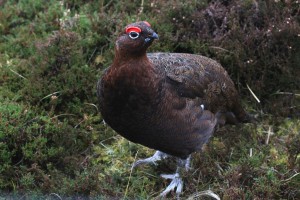 The commonest of the four members of the grouse family to be found in the Highlands is the red grouse as there are around 125,000 pairs in Scotland as a whole. The red grouse is now the epitome of the so called “quarry” birds and animals in that, in value terms, it is probably now more important than red deer stags or even salmon. In one sense, forgetting about the sporting/shooting side, it is very much a success story as without the intensive management of this type of countryside it needs it could well become extinct. The intensive management of vast tracts of open moorland is essential to the red grouse life cycle. The numbers of red grouse depend on two main factors with one that is outside our control, the weather. The second aspect is the balance between short heather with fresh growth and lots of insects for the chicks. There is also the other factor that longer heather is needed nearby as cover for adults and chicks against predators. This management is an art in itself and achieved by what is known as “muirburn”. This is the burning of heather in small strips so that the right conditions are achieved.
The commonest of the four members of the grouse family to be found in the Highlands is the red grouse as there are around 125,000 pairs in Scotland as a whole. The red grouse is now the epitome of the so called “quarry” birds and animals in that, in value terms, it is probably now more important than red deer stags or even salmon. In one sense, forgetting about the sporting/shooting side, it is very much a success story as without the intensive management of this type of countryside it needs it could well become extinct. The intensive management of vast tracts of open moorland is essential to the red grouse life cycle. The numbers of red grouse depend on two main factors with one that is outside our control, the weather. The second aspect is the balance between short heather with fresh growth and lots of insects for the chicks. There is also the other factor that longer heather is needed nearby as cover for adults and chicks against predators. This management is an art in itself and achieved by what is known as “muirburn”. This is the burning of heather in small strips so that the right conditions are achieved.
Unfortunately in recent years there has also been the tendency by some estates to think that animals and birds carry the ticks that can infest red grouse and bring diseases, and this has led to drastic measures. This is why on some estates large numbers of red, roe and sika deer are being culled, plus eradication in some parts of wild goats and mountain hares. In the last two years red grouse numbers have been high but there appears to be no difference between the estates that drastically kill other wildlife and those that leave well alone. The situation over wild goats is now that there are fewer of them in the Highlands than there has ever been which is shocking. One of the unfortunate aspects of the life cycle of red grouse is that they cannot be reared to boost stocks despite trials to this end. So the intense rearing to boost numbers, such as in partridges and pheasants, does not happen.
Members of the grouse family, particularly the largest of them, the capercaillie, are notorious for individuals being tame and even aggressive. Many a cock capercaillie has attacked people and even the much small red grouse can, on occasions, act in the same way. Last week a reader told me a cock red grouse that was so tame and aggressive it bit him on the finger. I have never seen this sort of behaviour until, by sheer co-incidence, it happened to me. I was in a car going over some high moorland near Inverness when there, on the side of the road, was a superb cock red grouse. I stopped and used the car as a hide to photograph the bird. Normally when the window goes down red grouse will run away and fly off, often calling. This cock bird was different as it not only stood its ground but it advanced on the car and was soon only a few feet away. Then it even began calling but not the crowing “go-back, go-back, go-back” but an annoyed “kwok, kwok, kwok”. At one stage the bird was so close the camera would not focus. What is interesting is that the photograph shows one special feature that enables this bird to survive the cold and snow, the feathered feet. It is an encounter I shall long remember as to be so close to this handsome cock bird was very moving.
Tags: highland wildlife
